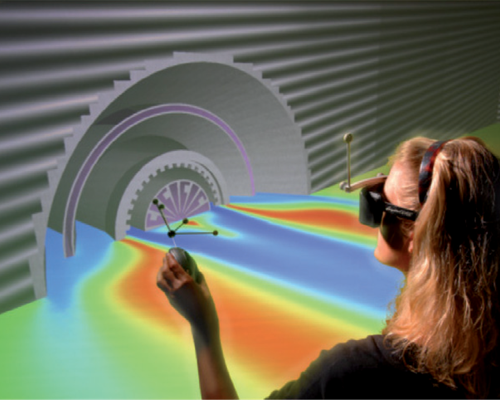ParMA: a major advance in High-Performance Computing (HPC) in Europe
Information Technology for European Advancement (ITEA) is a collaborative program founded by European high-tech enterprises, including Bull, under the auspices of the EUREKA initiative, with the aim of stimulating and supporting innovative research and development projects in information technology. Since it was established twelve years ago, ITEA and its successor ITEA 2 have co-financed more than a hundred projects, involving over 1,000 partners, enterprises and research laboratories in 30 countries. Every year, ITEA singles out those projects that have achieved the most outstanding results, from among the 20 or so currently in progress. In 2010 the ParMA project, led by Bull, has received the highest distinction, the Gold Achievement Award, with the committee commenting that they were: “impressed by the innovative character and rapid results achieved by ParMA”.
From left to right : Jean-Marc Morel, Bull ; Bernd Mohr, Jülich Supercomputing Center ; Bettina Krammer, Université de Versailles-St-Quentin (UVSQ) ; José Gracia, Université de Stuttgart (HLRS)
Tangible and spectacular results
Launched in June 2007, and partly founded by the French Ministry for the Economy, Industry & Employment,ParMA (Parallel Programming for Multi-Cores Architectures) has enabled the development of an Open Source, multi-platform tool for optimizing parallel computer simulation applications. The tool, named UNITE, has contributed to the enhancement of bullx®, voted the world’s best supercomputer in 2009 by HPCwire magazine. These important innovations in parallel computing have immediately led to some tangible and spectacular results. Most notably, one of the German partners, RECOM Services, won a contract for their 3D-combustion simulation tool, used to optimize fossil-fueled power stations, which enables their customer to save €125,000 and some 16,000 tons of CO2 emissions annually, thanks to the increase of performance obtained using the ParMA tools. At a time when High-Performance Computing (HPC) is becoming an indisputable, strategic driver for innovation and competitiveness, the ParMA project has made a striking contribution to European industry by providing it with such high caliber hardware and software solutions.
The aim of the ParMA project was to develop technologies that could fully exploit the multi-core architectures on which supercomputers are now based. Indeed, the advent of multi-core processors has enabled spectacular advances in computing power. Nonetheless, exploiting the true potential involves splitting up operations and distributing them between the various cores, something that requires the parallelization of applications. It’s not enough simply to re-write the code: the loading between the processing nodes must be rebalanced, and exchanges of data also have to be limited, as these then become the new limiting factor for performance. To this end you can tweak the various aspects of the logic (optimizing algorithms, using intelligent data management, setting up multiple cache levels…), and you can play around with physical aspects, notably limiting the relative ‘distance’ of tasks so as to minimize information flows. Finally, another issue is to make the whole system scalable in such a way that doubling the number of processors would effectively result in a doubling of program execution speed.
Bull: leading a multi-disciplinary community
Existing tools capable of resolving these kinds of challenges were limited, incomplete and incapable of taking into account the diversity and rapid evolution of supercomputing. But among customers in industry there is a growing need for parallel applications capable of handling huge volumes of data and/or parameters. To tackle this, ParMA has brought together simulation application publishers, publishers of specialist software development tools and suppliers of multi-core systems, as well as research laboratories and university computing centers including those at Jülich, Stuttgart and Dresden. As project leader, Bull has supplied the development and testing platform, a bullx HPC cluster located at les Clayes-sous-Bois (close to Paris), and has contributed its expertise in infrastructure tuning, especially since the relationship between software and hardware has to be extremely close when it comes to achieving maximum performance.
In addition to the development of UNITE[1] – the most advanced software package as far finalization and optimization of parallel applications is concerned – and improvements made to bullx, ParMA projects have resulted in the optimization of more than a dozen applications – with similar results to those obtained by RECOM Services – involving simulations ranging from casting modeling to numerical dosimetry used to simulate and evaluate dose exposure in real-time, thus characterizing the risk when people are exposed in a radioactive environment.. For example, at the last count the processing sequence of a metal forming simulation tool has been reduced from 13 hours to just 1 hour 30 minutes. Thanks to the excellent spirit of cooperation at the heart of this project, all participants have been able to significantly improve their knowledge and mastery of multi-core HPC systems, especially in the research laboratories. The latter have had the opportunity to take part in real programs and work with real data from real businesses, and so have had access to first-rate experimental material of immense value to them. It is these outcomes and the mutual enrichment of both the industry and research sectors in Europe that exemplifies all that ITEA has set out to promote, and that has brought ParMA its well deserved reward.
Moving towards Exascale computing
Today, the ParMA project is being extended in the form of a new project known as H4H (Hybrid for HPC), which brings together the existing community, along with some new, major industrial and scientific partners. The aim of this project is to take full advantage of the hybrid CPU+GPU architectures that are opening up new horizons for High-Performance Computing. Because ParMA – and now H4H – are facilitating much greater understanding of and expertise in the factors affecting supercomputer performance, they represent essential steps towards Exascale computing in Europe.
Bull: a key player in projects supported by ITEA
A founder member of ITEA, Bull maintains its unique standing in Europe as a key player in the entire IT value chain by participating actively in numerous projects.
- OSAMI-Commons (Open Source Ambient Intelligence Commons – on-going project)
The objective of the OSAMI-Commons project is to deliver a flexible, standard and Open Source SOA platform with a view to developing, deploying and exploiting ambient applications on every kind of server and communication terminal. - USENET (Ubiquitous M2M Service Networks – on-going project)
UseNet is developing an M2M (Machine-to-Machine) framework that is generic, but also standard, and capable of providing all services required for the implementation of new M2M applications, notably in home automation, the building industry and mobile apps. - Care4Me (Cooperative Advanced REsearch for Medical Efficiency – on-going project)
The aim of this project is to improve the quality and efficiency of the healthcare cycle, (prevention/diagnosis/treatment/control) through deployment of a faster and more accurate medical imaging system, decision support tools and integration within new hospital information systems. - HiPiP (High Performance Image Processing – on-going project)
The HiPiP project aims to demonstrate that the use of information systems from the highly parallelized market will yield far greater accuracy in medical imagery, and will therefore provide more precise, earlier diagnosis or even an early warning system in a clinical context. - MULTIPOL (Security policy in multi-domain environments – on-going project)
Led by Bull’s subsidiary Evidian, MULTIPOL aims to facilitate interoperability between independently administered areas of IT security with dynamic rights attribution geared to just fulfill the needs of external users. - Role-ID (Role-centric identity – on-going project)
Role-ID completes the classical identity infrastructure through an extension based on roles within the organization. - H4H (Hybrid4HPC – in-launch project)
Led by Bull, H4H aims to provide High-Performance Computing application developers with a hybrid parallel programming environment enabling the combined utilization of different programming models to enable heterogeneous CPU+GPU platforms to be exploited with the greatest possible efficiency. - ACDC (Adaptive Content Delivery Cluster – in-launch project)
Content coding, storage and indexing are the special interest of the ACDC project, which aims to implement intelligent multimedia applications executed on Cloud computing type architectures. - A2NETS (Autonomic services in M2M Networks – in-launch project)
A2Nets aims to provide a solution to the growing complexity of M2M network management, with an approach that tackles questions of autonomy, multiple utilizations and the interoperability of components.
[1] UNITE (UNified Integrated Tool Environment), can run on most HPC environments, and can be downloaded from http://apps.fz-juelich.de/unite/







